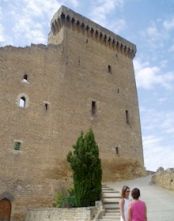|
The popes in Avignon - The
castle is build 1317-1333
For reasons not to be discussed here the popes settled in Avignon
in 1305. The first pope in Avignon was Clément V (1305-1314) and then followed 8 other popes: Jean XXII
(1316-1334; also called John or Johannes), Benedict XII (1334-1342), Clement VI (1342-1352), Innocent VI
(1352-1362), Urban V (1362-1370), Gregory XI (1370-1378). Gregory XI restored
the Papacy in Rome in 1376. During the time of 2 popes "the Great Schism"
Clement VII (1378-1394) and Benedict XIII (1394-1423) had their
divided papacy in Avignon until 1403 where Avignon was abandoned definitively as
the Papal seat.
Before 1305 Avignon and Comtat de Venaissin including Chateauneuf du Pape (Chateauneuf
Calcernier)
were part of "the Holy See" (the papal possessions), which probably was the main
reason for the choice of Avignon as papal city. It was the two first popes who
had the most significant importance for Chateauneuf. Clement V visited the
fortified town in several periods of his papacy and his succeser Jean XXII started to build the castle soon after his election and having finished the
building in 1333 he died only a year later in 1334.
The following popes did not often go to Chateauneuf. The next pope - and last
- who has seemed to enjoy staying in Chateauneuf was Clement VII. From 1383 he
apparently found safety here and the castle became his favourite residence. The
pontical court was removed to Chateauneuf during the plague in Avignon, and in
1385-1387 some maintenance work was done at the castle.
.
|
|
After the popes in Avignon no one ever since had the will or resources to keep
up the castle. The bishops or archbishops of Avignon were not particularly
interested in the castle and it was never of great strategic importance and therefore
it fell in to disrepair. People lived at the place, but it was mostly small
groups of soldiers commanded by a captain or a lieutenant.
In 1563 the castle was captured by the hugenots and they put the great hall on
fire. The walls and the towers kept standing but the buildings were never
restored in full scale. One archbishop discovered the building in its sad state
in the last part of XVII century and made some parts of it livable - for a short
time. Little by little the buildings became completly forsaken.
After the French revolution,in 1798, the castle and its field (9,2 hectares)
were sold for the highest bid to J. B. Establet, and shortly after he resold it
in equal shares to 33 of his fellow citizens. Then much of the castle
disappeared because the stones were used for house building in the town. In 1858
the ground floor of the donjon was rented for storing of materiel under the
condition "of letting visit the appartment by all foreigners who will wish to
see it".
In 1892 the ruin was given to the French state and classified as a historic
building. Thus to keep the ruin in the state of that time.
One more historic accident hit the castle. During World War II the Germans used
the donjon as a depot for ammunition. When they had to retire from the area in
1944 they removed the ammunition by letting it explode. Thereby the northern
wall of the donjon was blown away. It's not fair to say that the Germans made
the popes castle into a ruin. It had been a ruin for centuries but of cource they
are to blame for some damage.
.
|





